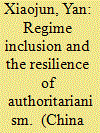| Srl | Item |
| 1 |
ID:
105856


|
|
|
|
|
| Publication |
2011.
|
| Summary/Abstract |
Between 1991 and 2001, Qian Xuesen, China's leading missile expert, was given an array of honourable titles by the state, followed by eulogistic narratives by the media and his biographers. This article analyses three forms of Chinese narratives about Qian: commendations from the state, stories told by his biographers, and Qian's self-presentation. It aims to show that although the CCP showered Qian with compliments seemingly because of his contributions to China's national defence and space programmes, the real reasons were Qian's political fidelity and the Party's aim to build a role model for intellectuals to emulate. The article demonstrates that Maoist practices of "hero construction" and using history for the present persist in the post-Mao period with some variations, and that the writings of "unofficial history" are heavily influenced by official history.
|
|
|
|
|
|
|
|
|
|
|
|
|
|
|
|
| 2 |
ID:
106759


|
|
|
| 3 |
ID:
196086


|
|
|
|
|
| Summary/Abstract |
Based on visual analysis of the China Pictorial magazine in two historical periods (Mao and post-Mao), this article identifies six key themes of representing Africa in Chinese state media and finds a parallel between China’s representation of Africa, Sino-African relations, and the shifting geopolitics. Different from Western stereotypes about Africa, China Pictorial constructs a romanticized image of Africa, which is interpreted through the concept of the “socialist gaze.” Empirically, this article explains and historicizes how China Pictorial constructs meanings about Africa through its visual representational systems, shedding new light on China–Africa relations and the increasingly active South–South media flows. Theoretically, this article expands our understanding of media representation beyond the “colonial gaze.” While the “socialist gaze” may function as a counter-representation to the “colonial gaze,” it can also create new differences and stereotypes, thus enhancing power asymmetry between China and Africa.
|
|
|
|
|
|
|
|
|
|
|
|
|
|
|
|